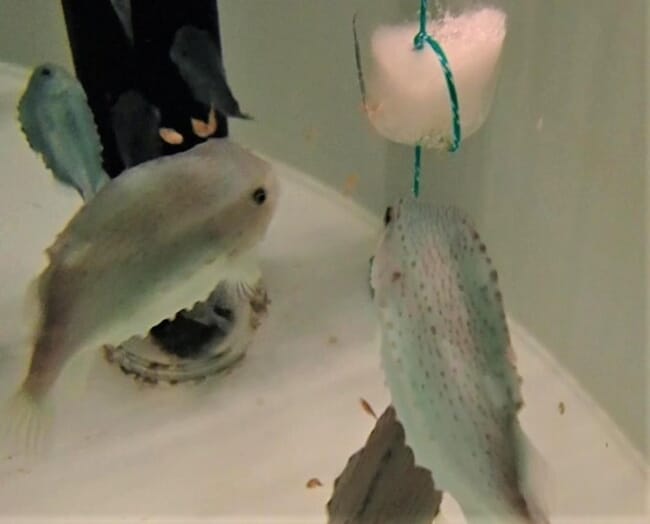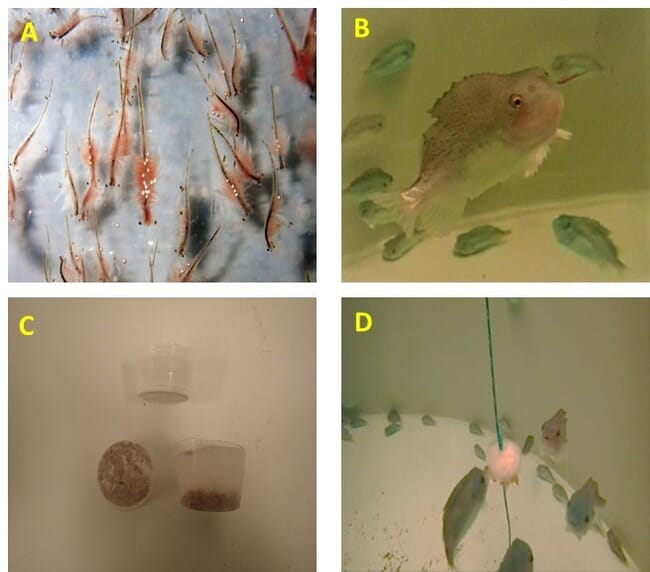The research, conducted by scientists from Akvaplan-niva, the University of Bergen and GIFAS, has recently been published under the title Improving sea lice grazing of lumpfish (Cyclopterus lumpus L.) by feeding live Artemia and frozen sea lice feeds prior to transfer to Atlantic salmon (Salmo salar L.) net-pens, in the journal Aquaculture.

© GIFAS
Background
Recently lumpfish (Cyclopterus lumpus L.) have been suggested as a cold-water cleaner fish for removal of sea lice from Atlantic salmon and initial studies showed promise with up to 93–97 percent lower sea lice infection (adult female lice) in sea pens with lumpfish (Imsland et al., 2014 a-c). However, in these studies large individual differences in feeding preferences between lumpfish and their sea lice grazing activity has been indicated.
To enhance the effect of lumpfish in the sea cages, it is critical to increase the number that actually eat the lice. Previous trials have indicated that grazing on sea lice can increase with the time spent in the sea cages (Imsland et al., 2014 a-c). This indicates a learning, or conditioning, process in the lumpfish and that those fish that have been conditioned into eating sea lice are the most efficient as a delousing agent. Accordingly, the researchers aimed to investigate whether lumpfish exposed to live feed, or frozen sea lice, during the early juvenile phase will be more efficient delousing agents when reared together with salmon in cages at a later stage.
Study details
Two groups of PIT-tagged lumpfish (initial mean weight ± SD, 22.3 ± 2.5 g) were established in land-based tanks. One group received marine pelleted feed (MF group) whilst the other received a mix of pelleted feed, live adult Artemia and frozen sea lice (LF group) (image 1), both groups with a feeding rate of 2 percent body weight−1 per day for a period of 122 days. After this period 60 lumpfish (mean weight ± SD, 118.1 ± 7.7 g) mean from each group were Floy-tagged and transferred to four 5×5×5m sea-pens containing 300 Atlantic salmon (mean weight ± SD, 668.4 ± 13.9 g), 30 lumpfish in each replicate sea pen. Two sea pens containing salmon only acted as controls. The sea pen study period lasted for 62 days. Individual weights and behaviour of the lumpfish were recorded every other week throughout the study period. In addition, regular lice counts were done, and the salmon were bulk weighed at the start and end of the study period.
Results
Growth performance
There were no differences in mean weights, condition factor or specific growth rate between the two groups during the tank-based phase of the study. In the sea pens, mortality was low in both groups and mean weights was similar for both groups and condition factor and SGR followed similar trajectories as the study progressed.

© GIFAS
The researchers note that there were consistently lower average numbers of all stages of L. salmonis and C. elongatus for both lumpfish groups compared to the control group with no lumpfish present. The same pattern was evident for both mature female, pre-adult and combined pre-adult and mature male lice counts. At the end of the study period, salmon in the presence of lumpfish from the LF group had 73 percent fewer L. salmonis (all stages) whereas, salmon in the presence of lumpfish from the MF group had 50 percent fewer L. salmonis compared to the control group. There were also differences between the two lumpfish treatment groups and at the termination of the trial there was 23 percent fewer L. salmonis and 38 percent fewer C. elongatus found on salmon reared with the LF lumpfish compared to the MF lumpfish. These results suggest that lumpfish fed Artemia and frozen sea lice prior to transfer to sea pens consumed more sea lice compared to the marine feed group.
Lumpfish exhibited a limited palette of behaviour types dominated by feed searching and feeding. However, there were differences in the frequency of behavioural types between the two groups throughout the study period. The consistency of the differences in the behaviour shown may indicate that the dietary treatment during Part I resulted in a persistently altered behaviour. The effect of the dietary treatment resulted in the LF fish displaying behaviour where they rest more and are more prone to utilise the natural resources in the cage while the fish in the MF group hover more and swim at the observer to a larger degree. The types of behaviours seen in the MF group are not beneficial to the fish, as hovering and swimming at the observer does not provide the fish with feed, nor conserve energy.
Conclusions
The researchers concluded that: “lumpfish exposed to live prey and frozen sea lice prior to transfer to sea pens with salmon have the ability to learn and recognize this prey after transfer”.
They add that: “This skill was evident throughout the study period as the presence of LF fish in cages with salmon as compared to MF fish resulted in lower infestation levels. The effect of the conditioning treatment was also manifested in the behaviour of the lumpfish as the fish from the LF group spent more time resting, more time swimming along the net sides, and eating at biofouling. Fish in the MF group on the other hand, showed a more active behaviour pattern with more swimming, both at observer and among the salmon, and used less time resting.
Moreover, they continue: “It is concluded that conditioning to live feed and frozen sea lice prior to deployment of the lumpfish into open net-pens, can alter the fish's efficiency in delousing salmon.”
Acknowledgements
The authors of the study would like to thank the technical staff at GIFAS aquaculture research station at Inndyr for valuable assistance prior to and during the experimental period and Meløy Videregaende Skole for providing access to their marine hall. Financial support was given by The Research Council of Norway (LUSINFER 256199).




